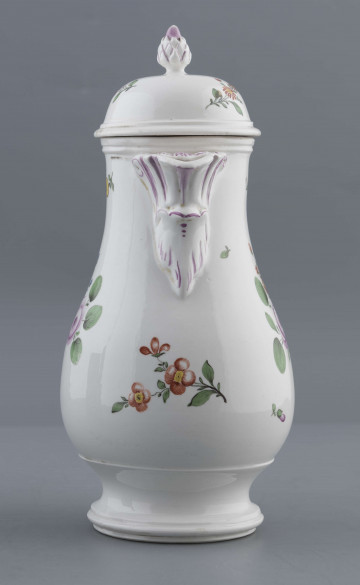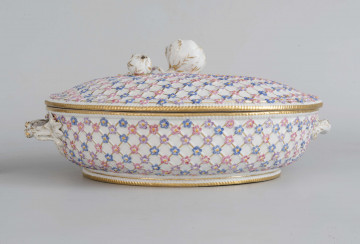
Coffee pot
1800 — 1820
National Museum in Lublin
Part of the collection: European porcelain
On the banks of the Elbe River is the city of Meissen, which owes its fame to the oldest porcelain factory in Europe. It is here that for more than three hundred years the best artists, sculptors and craftsmen have been designing, producing and decorating porcelain masterpieces with unparalleled precision.
In the first half of the 17th century, August II Strong Elector of Saxony and King of Poland, commissioned his most eminent alchemists to invent a recipe for producing gold. They failed in inventing a recipe for producing this precious element, but by chance they did make a breakthrough discovery which enabled them to develop a method for producing porcelain. In addition, in 1707 a rich deposit of kaolin clay was discovered near Meissen, the availability of which enabled the first white porcelain to be produced a year later. King Augustus, wanting to protect the secret and valuable recipe, did not decide to set up a factory in Dresden and in 1710 at Albrechtsburg Castle opened the oldest and still functioning manufactory in Europe.
Meissen and its manufactory became famous not only for the production of porcelain table suits but above all for the innumerable sculptures and figurines which were intended to add variety to the table setting and in time became an indispensable part of it. Artists from Meissen, such as Eberlein Johann Friedrich, whose works can be found in the National Museum in Lublin, immortalised human and animal figures in painted figurines. The porcelain sculptures entertained their owners and guests not only when drinking coffee or tea, but also when drinking wine. It is therefore not surprising that Bacchus, the Roman god of wildlife, vines and wine, is seated on a porcelain barrel. The figure clutches a grape in one hand and holds a golden goblet in the other, raised in a toasting gesture, encouraging the revellers to discover the beneficial and intoxicating effects of the drink enclosed in the white barrel.
Author / creator
Dimensions
cały obiekt: height: 56 cm
Object type
vessel
Technique
overglaze paints
Material
porcelain
Creation time / dating
Creation / finding place
Owner
The National Museum in Lublin
Identification number
Location / status

1800 — 1820
National Museum in Lublin

1763 — 1774
National Museum in Lublin

1800 — 1810
National Museum in Lublin
DISCOVER this TOPIC
Castle Museum in Łańcut
DISCOVER this PATH
Educational path